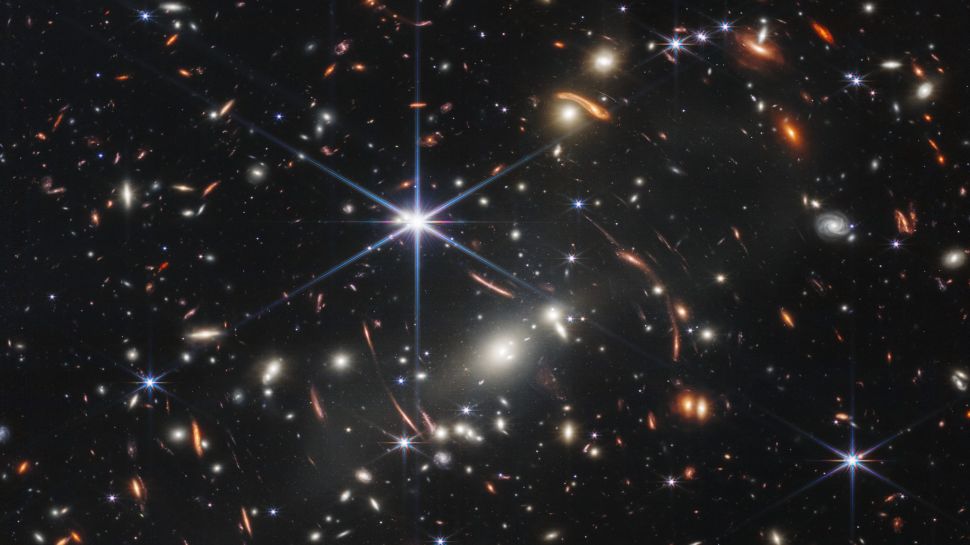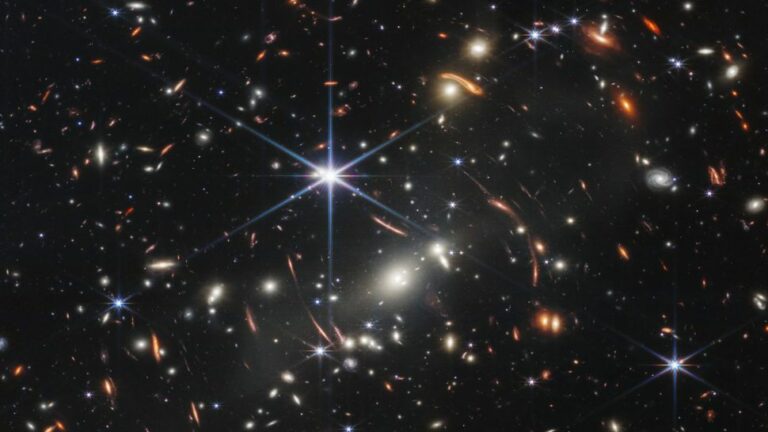James Webb Space Telescope surpasses its own benchmark by perhaps detecting the most distant galaxies
The treasure trove of early data from the James Webb Space Telescope has unearthed the most distant galaxies ever seen.
As they filter through the vast amount of data being gathered by the James Webb Space Telescope, astronomers are suddenly finding record-breaking faraway galaxies by the dozen (JWST or Webb). Several galaxies among them are older than 200 million years after the Big Bang.
The most distant verified galaxy prior to the James Webb Space Telescope’s deployment was GN-z11, which scientists observed when it was roughly 420 million years after the Big Bang, giving it what astronomers refer to as a redshift of 11.6. (Redshift tells how much the cosmos has stretched the light originating from a galaxy. The further back in time we perceive a galaxy, the higher the redshift.)

A week after the first JWST scientific photos were made public, scientists announced the discovery of galaxies at redshift 13, or around 300 million years after the Big Bang. The record is now being broken by a fresh wave of scientific discoveries, with some astronomers claiming the discovery of galaxies up to a redshift of 20. If this is the case, then we are witnessing these galaxies in their pre-Big Bang state.
That’s a huge if because none of these redshift estimates have been verified as of yet. It will take spectroscopic study, which divides an object’s light into a spectrum, to verify the distances of these galaxies. The analysis will be presented later. But it is apparent that JWST is completely competent to find galaxies from this long-gone age.
Different methods have been used to find the galaxies. SMACS J0723’s gravitational lens helped astronomers headed by Haojing Yan of the University of Missouri–Columbia find 88 candidate galaxies beyond a redshift of 11, including a few that are thought to be at a redshift of 20. These galaxies would be the furthest ones ever discovered if confirmed.
These galaxies would be more than 35 billion light-years away from us now due to cosmic expansion.
In two other studies, high-redshift galaxies are discovered in regions of the sky where JWST has only made deep exposures without using gravitational lensing. These photos are a part of the Cosmic Evolution Early Release Science (CEERS) survey, which was taken by JWST’s Near-Infrared Camera on photographs of 10 distinct areas of the sky (NIRCam). Six of these patches are observed by JWST’s Near-Infrared Spectrograph (NIRSpec), while the Mid-Infrared Instrument (MIRI) focuses on four of them.
Callum Donnan, a Ph.D. candidate at the University of Edinburgh, led a team of astronomers that discovered a candidate galaxy at a redshift of 16.7, or only 250 million years after the Big Bang. The team also discovered five more galaxies, all of which have redshifts larger than 12, breaking the previous record for redshift set by the Hubble Space Telescope, the JWST’s predecessor and current collaborator.
Another team led by Steven Finkelstein of the University of Texas at Austin discovered a galaxy using the same observations from CEERS that has a redshift of 14.3, placing it 280 million years after the Big Bang. The researchers have named this galaxy “Maisie’s Galaxy” in honor of Finkelstein’s daughter.
The researchers discovered that the Hubble Space Telescope may have also observed this galaxy, although it was not known about at the time. If a detailed examination of the archival data does really identify the galaxy, Maisie’s Galaxy must have emitted extremely intense ultraviolet radiation as a result of a significant burst of star creation for Hubble to have discovered it.
In fact, all of the possible distant galaxies show evidence of significant ultraviolet light emission, which may be sufficient to resolve the question of what ionized the hydrogen gas in the cosmos and end the so-called “Cosmic Dark Ages.” Astronomers have proposed a variety of explanations throughout the years, from radiation from the earliest stars and galaxies to the first supermassive black holes’ radiation outflows.
The “galaxy ultraviolet luminosity function” between redshifts of 8 and 15 is calculated by Donnan’s team in their publication. The quantity of ultraviolet light emitted by galaxies at any given time is averaged out using this function. Because a galaxy produces more ultraviolet light when more hot, young stars are forming there, the value is closely related to star formation. According to Donnan’s team, the stars in these early galaxies release more than enough UV light to ionize the cosmos.
These newly discovered high-redshift galaxies can be viewed as cosmic newborns. In contrast to current galaxies, which may house hundreds of billions of stars, these galaxies are merely a few thousand light-years across and only contain tens of millions of stars. The cosmic infants, according to astronomers, might be as young as 20 million years old and are thought to be less than 100 million years old.
The very first galaxies in the universe, which could be located at redshift 25 or beyond, have not yet been discovered by scientists. However, the newly discovered galaxies reflect generations of galaxies that came just after and are still in their infancy, according to experts.
The quantity of high-redshift galaxies that JWST is discovering so early in its mission, along with the amount of ultraviolet light (redshifted into the longer wavelengths of infrared, making it visible to JWST), imply that galaxies were numerous in the early history of the universe. In contrast to certain predictions, there may be a steady fall in star formation as we go further back in time as opposed to a sudden decline beyond redshift 11.
According to Finkelstein’s team, if more spectroscopy confirms these redshifts, “our cosmos was already aglow with galaxies less than 300 million years after the Big Bang.”
The following issues include how far back in time JWST can view and if it will be sufficient to find the very first galaxies that existed, maybe only 100 million years after the Big Bang. JWST has detected these strong galaxy candidates at great distances. Since it would depend on accidental gravitational lensing to bring primordial galaxies into view, such a finding would demand a significant amount of good fortune.
The Yan paper can be found here; the Donnan paper here; and the Finkelstein paper here
Do not forget to share your opinion with us to provide you with the best posts !




0 Comments